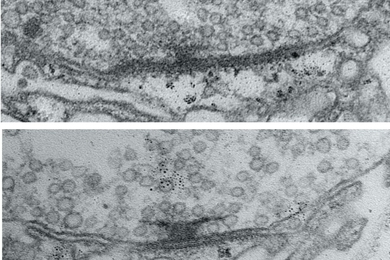MIT researchers have devised a new method for shrinking the size of crystals to make safer metal alloys. The new materials could replace metal coatings such as chromium, which is dangerous for factory workers to produce.
The method, developed by Associate Professor Christopher Schuh and graduate student Andrew Detor, both of the Department of Materials Science and Engineering, involves making the crystals within an alloy (a combination of two or more metals) smaller and thus harder.
For the chromium replacement, the two made crystals of nickel and tungsten small enough that the resulting alloy is as hard as chromium. The trick is a new twist on electroplating that involves manipulating -- on the nanoscale, or billionths of a meter -- how the nickel and tungsten atoms are��laid down as they are plated onto��another metal.����
While so-called hard chromium is used to coat industrial parts and decorative items such as automobile bumpers, the coating process uses a form of chromium called hexavalent chromium that has been linked to cancer and other adverse health effects if workers inhale it. A steel ring, for example, is coated using a bath of hexavalent chromium that gives off harmful fumes.
While exhaust hoods are used to take away much of the fumes, the federal government currently is considering tougher safety standards for workers exposed to the baths. That has led industrial companies to look for metals that will not give off the harmful fumes. Schuh says the new alloy is one such safer alternative.
"The ability to control the structure of a metal to nearly the atomic scale is new and enables us to make the alloy very hard," Schuh said.
He compared the method to making a wall out of stones and mortar. Using large stones doesn't require much mortar, but smaller stones require more mortar, which makes for a stronger stone wall.
In the new chromium replacement, each microscopic piece of nickel is surrounded by even tinier bits of tungsten. The researchers control how the tungsten fills in the spaces between the pieces of nickel, thus creating a tighter and stronger crystal structure than metals and alloys with larger crystals.
In addition to producing safer alternative metal coatings, the method also allows for manipulating the structure of metals to improve their resistance to cracking, corrosion and other wear and tear, Schuh said. Schuh already has tested steel coated with chromium and his new alloy, and the alloy has held up better against some types of corrosion.
Schuh said that while replacing chromium as a metal coating is likely to be the initial application of this method, other nanostructure alloys could be used to replace other metal coatings in the future.
Hexavalent chromium, the material Schuh hopes to replace, is used in just about every major heavy industry worldwide. It has been under scrutiny since the early 1970s and was the subject of the movie, "Erin Brockovich." New environmental standards on hexavalent chromium expected soon from the Occupational Safety and Health Administration (OSHA) could be 50 times more stringent than current standards.
More than 25,000 U.S. workers are exposed to hexavalent chromium each year in the chrome-plating process alone, according to OSHA figures. And that's only a fraction of the total number exposed to the carcinogen.
"Other countries also are introducing significant new controls, so this is a problem that is not going to go away," said Schuh. He said he expects industries using hexavalent chromium to undergo major structural changes to meet the new standards, including seeking alternative materials for plating.
Schuh has filed for two patents on the technology. An article on the new method is to appear this summer in the Materials Research Society Proceedings.
Schuh, along with Alan Lund, a former researcher at MIT, also is a co-founder of a company called Xtalic Corp. of Medford, Mass., which will license the intellectual property from MIT. It aims to commercialize the metal-coating technology based on nanostructure alloys.
The U.S. Army Research Office funded the work.
A version of this article appeared in MIT Tech Talk on February 15, 2006 (download PDF).






